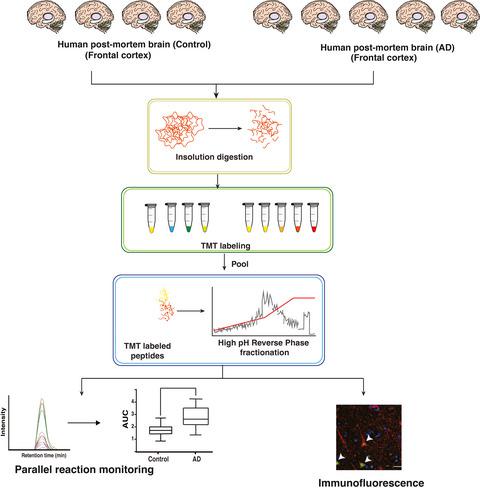当前位置:
X-MOL 学术
›
J. Neurochem.
›
论文详情
Our official English website, www.x-mol.net, welcomes your
feedback! (Note: you will need to create a separate account there.)
Quantitative proteomic analysis of the frontal cortex in Alzheimer’s disease
Journal of Neurochemistry ( IF 4.2 ) Pub Date : 2020-07-02 , DOI: 10.1111/jnc.15116 Gajanan Sathe 1, 2, 3, 4 , Marilyn Albert 5 , Jacqueline Darrow 5 , Atsushi Saito 6 , Juan Troncoso 6 , Akhilesh Pandey 3, 7 , Abhay Moghekar 5
Journal of Neurochemistry ( IF 4.2 ) Pub Date : 2020-07-02 , DOI: 10.1111/jnc.15116 Gajanan Sathe 1, 2, 3, 4 , Marilyn Albert 5 , Jacqueline Darrow 5 , Atsushi Saito 6 , Juan Troncoso 6 , Akhilesh Pandey 3, 7 , Abhay Moghekar 5
Affiliation

|
Alzheimer's disease (AD) is a chronic neurodegenerative disease characterized by intracellular formation of neurofibrillary tangles and extracellular deposition of β‐amyloid protein (Aβ) in the extracellular matrix. The pathogenesis of AD has not yet been fully elucidated and little is known about global alterations in the brain proteome that are related to AD. To identify and quantify such AD‐related changes in the brain, we employed a tandem mass tags approach coupled to high‐resolution mass spectrometry. We compared the proteomes of frontal cortex from AD patients with corresponding age‐matched brain samples. Liquid chromatography–mass spectrometry/MS analysis carried out on an Orbitrap Fusion Lumos Tribrid mass spectrometer led to identification of 8,066 proteins. Of these, 432 proteins were observed to be significantly altered (>1.5 fold) in their expression in AD brains. Proteins whose abundance was previously known to be altered in AD were identified including secreted phosphoprotein 1 (SPP1), somatostatin (SST), SPARC‐related modular calcium binding 1 (SMOC1), dual specificity phosphatase 26 (DUSP26), and neuronal pentraxin 2 (NPTX2). In addition, we identified several novel candidates whose association with AD has not been previously described. Of the novel molecules, we validated chromogranin A (CHGA), inner membrane mitochondrial protein (IMMT) and RAS like proto‐oncogene A (RALA) in an additional set of 20 independent brain samples using targeted parallel reaction monitoring mass spectrometry assays. The differentially expressed proteins discovered in our study, once validated in larger cohorts, should help discern the pathogenesis of AD.
中文翻译:

阿尔茨海默病额叶皮层的定量蛋白质组学分析
阿尔茨海默病(AD)是一种慢性神经退行性疾病,其特征是细胞内神经原纤维缠结的形成和细胞外基质中β-淀粉样蛋白(Aβ)的沉积。 AD 的发病机制尚未完全阐明,并且与 AD 相关的大脑蛋白质组的整体改变知之甚少。为了识别和量化大脑中与 AD 相关的变化,我们采用了串联质量标签方法与高分辨率质谱法相结合。我们将 AD 患者额叶皮层的蛋白质组与相应年龄匹配的大脑样本进行了比较。在 Orbitrap Fusion Lumos Tribrid 质谱仪上进行液相色谱-质谱/MS 分析,鉴定出 8,066 种蛋白质。其中,432 种蛋白质在 AD 大脑中的表达被观察到显着改变(>1.5 倍)。先前已知 AD 中丰度发生改变的蛋白质已被鉴定,包括分泌性磷蛋白 1 (SPP1)、生长抑素 (SST)、SPARC 相关模块化钙结合 1 (SMOC1)、双特异性磷酸酶 26 (DUSP26) 和神经元五聚蛋白 2( NPTX2)。此外,我们还发现了一些新的候选者,其与 AD 的关联以前从未被描述过。在这些新分子中,我们使用靶向平行反应监测质谱分析在另一组 20 个独立脑样本中验证了嗜铬蛋白 A (CHGA)、内膜线粒体蛋白 (IMMT) 和 RAS 样原癌基因 A (RALA)。我们的研究中发现的差异表达蛋白一旦在更大的队列中得到验证,应该有助于辨别 AD 的发病机制。
更新日期:2020-07-02
中文翻译:

阿尔茨海默病额叶皮层的定量蛋白质组学分析
阿尔茨海默病(AD)是一种慢性神经退行性疾病,其特征是细胞内神经原纤维缠结的形成和细胞外基质中β-淀粉样蛋白(Aβ)的沉积。 AD 的发病机制尚未完全阐明,并且与 AD 相关的大脑蛋白质组的整体改变知之甚少。为了识别和量化大脑中与 AD 相关的变化,我们采用了串联质量标签方法与高分辨率质谱法相结合。我们将 AD 患者额叶皮层的蛋白质组与相应年龄匹配的大脑样本进行了比较。在 Orbitrap Fusion Lumos Tribrid 质谱仪上进行液相色谱-质谱/MS 分析,鉴定出 8,066 种蛋白质。其中,432 种蛋白质在 AD 大脑中的表达被观察到显着改变(>1.5 倍)。先前已知 AD 中丰度发生改变的蛋白质已被鉴定,包括分泌性磷蛋白 1 (SPP1)、生长抑素 (SST)、SPARC 相关模块化钙结合 1 (SMOC1)、双特异性磷酸酶 26 (DUSP26) 和神经元五聚蛋白 2( NPTX2)。此外,我们还发现了一些新的候选者,其与 AD 的关联以前从未被描述过。在这些新分子中,我们使用靶向平行反应监测质谱分析在另一组 20 个独立脑样本中验证了嗜铬蛋白 A (CHGA)、内膜线粒体蛋白 (IMMT) 和 RAS 样原癌基因 A (RALA)。我们的研究中发现的差异表达蛋白一旦在更大的队列中得到验证,应该有助于辨别 AD 的发病机制。











































 京公网安备 11010802027423号
京公网安备 11010802027423号